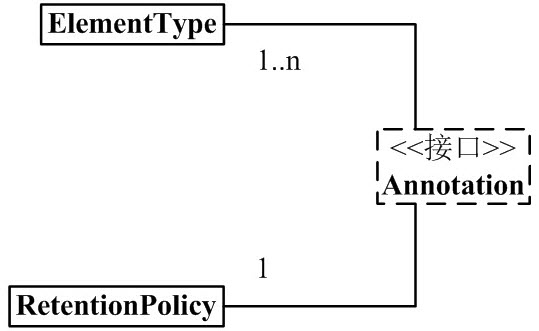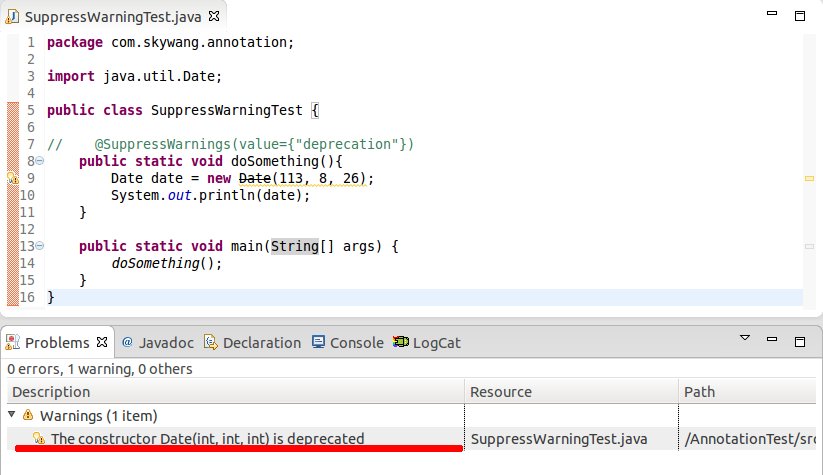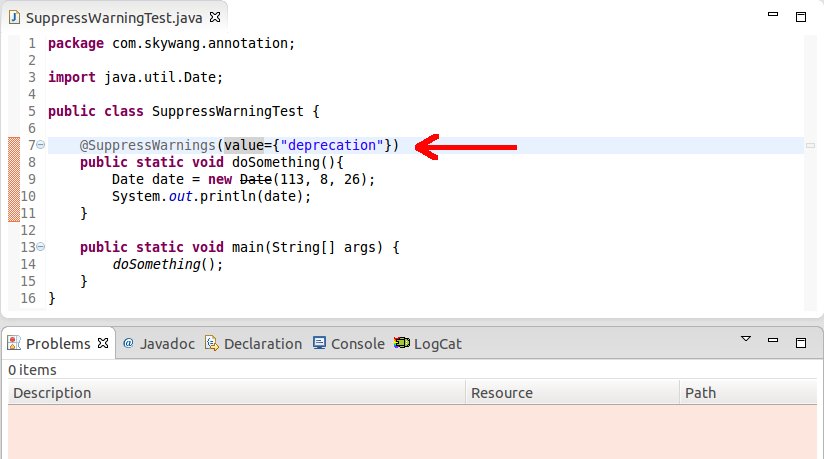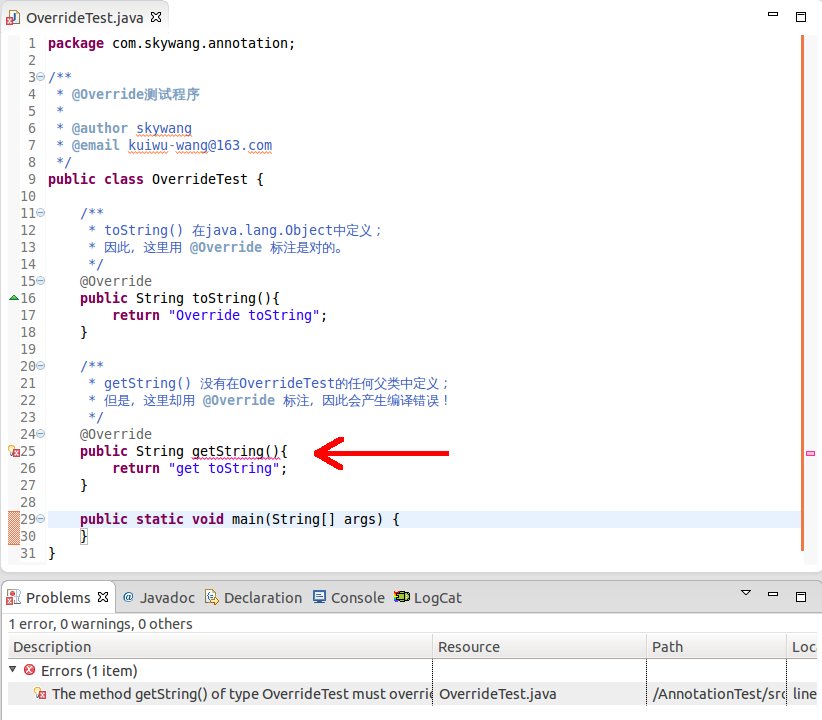Java Annotation认知(包括框架图、详细介绍、示例说明)
摘要
Java Annotation是JDK5.0引入的一种注释机制。
网上很多关于Java Annotation的文章,看得人眼花缭乱。Java Annotation本来很简单的,结果说的人没说清楚;弄的看的人更加迷糊。
我按照自己的思路,对Annotation进行了整理。理解 Annotation 的关键,是理解Annotation的语法和用法,对这些内容,我都进行了详细说明;理解Annotation的语法和用法之后,再看Annotation的框架图,可能有更深刻体会。废话就说这么多,下面开始对Annotation进行说明。若您发现文章中存在错误或不足的地方,希望您能指出!
第1部分 Annotation架构
先看看Annotation的架构图:

从中,我们可以看出:
(01) 1个Annotation 和 1个RetentionPolicy关联。
可以理解为:每1个Annotation对象,都会有唯一的RetentionPolicy属性。
(02) 1个Annotation 和 1~n个ElementType关联。
可以理解为:对于每1个Annotation对象,可以有若干个ElementType属性。
(03) Annotation 有许多实现类,包括:Deprecated, Documented, Inherited, Override等等。
Annotation 的每一个实现类,都“和1个RetentionPolicy关联”并且“和1~n个ElementType关联”。
下面,我先介绍框架图的左半边(如下图),即Annotation, RetentionPolicy, ElementType;然后在就Annotation的实现类进行举例说明。

第2部分 Annotation组成部分
1 annotation组成成分
java annotation 的组成中,有3个非常重要的主干类。它们分别是:
(01) Annotation.java
package java.lang.annotation; public interface Annotation { boolean equals(Object obj); int hashCode(); String toString(); Class<? extends Annotation> annotationType(); }
(02) ElementType.java
package java.lang.annotation; public enum ElementType { TYPE, /* 类、接口(包括注释类型)或枚举声明 */ FIELD, /* 字段声明(包括枚举常量) */ METHOD, /* 方法声明 */ PARAMETER, /* 参数声明 */ CONSTRUCTOR, /* 构造方法声明 */ LOCAL_VARIABLE, /* 局部变量声明 */ ANNOTATION_TYPE, /* 注释类型声明 */ PACKAGE /* 包声明 */ }
(03) RetentionPolicy.java
package java.lang.annotation; public enum RetentionPolicy { SOURCE, /* Annotation信息仅存在于编译器处理期间,编译器处理完之后就没有该Annotation信息了 */ CLASS, /* 编译器将Annotation存储于类对应的.class文件中。默认行为 */ RUNTIME /* 编译器将Annotation存储于class文件中,并且可由JVM读入 */ }
说明:
(01) Annotation 就是个接口。
“每1个Annotation” 都与 “1个RetentionPolicy”关联,并且与 “1~n个ElementType”关联。可以通俗的理解为:每1个Annotation对象,都会有唯一的RetentionPolicy属性;至于ElementType属性,则有1~n个。
(02) ElementType 是Enum枚举类型,它用来指定Annotation的类型。
“每1个Annotation” 都与 “1~n个ElementType”关联。当Annotation与某个ElementType关联时,就意味着:Annotation有了某种用途。
例如,若一个Annotation对象是METHOD类型,则该Annotation只能用来修饰方法。
(03) RetentionPolicy 是Enum枚举类型,它用来指定Annotation的策略。通俗点说,就是不同RetentionPolicy类型的Annotation的作用域不同。
“每1个Annotation” 都与 “1个RetentionPolicy”关联。
a) 若Annotation的类型为 SOURCE,则意味着:Annotation仅存在于编译器处理期间,编译器处理完之后,该Annotation就没用了。
例如,“ @Override ”标志就是一个Annotation。当它修饰一个方法的时候,就意味着该方法覆盖父类的方法;并且在编译期间会进行语法检查!编译器处理完后,“@Override”就没有任何作用了。
b) 若Annotation的类型为 CLASS,则意味着:编译器将Annotation存储于类对应的.class文件中,它是Annotation的默认行为。
c) 若Annotation的类型为 RUNTIME,则意味着:编译器将Annotation存储于class文件中,并且可由JVM读入。
这时,只需要记住“每1个Annotation” 都与 “1个RetentionPolicy”关联,并且与 “1~n个ElementType”关联。学完后面的内容之后,再回头看这些内容,会更容易理解。
第3部分 java自带的Annotation
理解了上面的3个类的作用之后,我们接下来可以讲解Annotation实现类的语法定义了。
1 Annotation通用定义
@Documented @Target(ElementType.TYPE) @Retention(RetentionPolicy.RUNTIME) public @interface MyAnnotation1 { }
说明:
上面的作用是定义一个Annotation,它的名字是MyAnnotation1。定义了MyAnnotation1之后,我们可以在代码中通过“@MyAnnotation1”来使用它。
其它的,@Documented, @Target, @Retention, @interface都是来修饰MyAnnotation1的。下面分别说说它们的含义:
(01) @interface
使用@interface定义注解时,意味着它实现了java.lang.annotation.Annotation接口,即该注解就是一个Annotation。
定义Annotation时,@interface是必须的。
注意:它和我们通常的implemented实现接口的方法不同。Annotation接口的实现细节都由编译器完成。通过@interface定义注解后,该注解不能继承其他的注解或接口。
(02) @Documented
类和方法的Annotation在缺省情况下是不出现在javadoc中的。如果使用@Documented修饰该Annotation,则表示它可以出现在javadoc中。
定义Annotation时,@Documented可有可无;若没有定义,则Annotation不会出现在javadoc中。
(03) @Target(ElementType.TYPE)
前面我们说过,ElementType 是Annotation的类型属性。而@Target的作用,就是来指定Annotation的类型属性。
@Target(ElementType.TYPE) 的意思就是指定该Annotation的类型是ElementType.TYPE。这就意味着,MyAnnotation1是来修饰“类、接口(包括注释类型)或枚举声明”的注解。
定义Annotation时,@Target可有可无。若有@Target,则该Annotation只能用于它所指定的地方;若没有@Target,则该Annotation可以用于任何地方。
(04) @Retention(RetentionPolicy.RUNTIME)
前面我们说过,RetentionPolicy 是Annotation的策略属性,而@Retention的作用,就是指定Annotation的策略属性。
@Retention(RetentionPolicy.RUNTIME) 的意思就是指定该Annotation的策略是RetentionPolicy.RUNTIME。这就意味着,编译器会将该Annotation信息保留在.class文件中,并且能被虚拟机读取。
定义Annotation时,@Retention可有可无。若没有@Retention,则默认是RetentionPolicy.CLASS。
2 java自带的Annotation
通过上面的示例,我们能理解:@interface用来声明Annotation,@Documented用来表示该Annotation是否会出现在javadoc中, @Target用来指定Annotation的类型,@Retention用来指定Annotation的策略。
理解这一点之后,我们就很容易理解java中自带的Annotation的实现类,即Annotation架构图的右半边。如下图:

java 常用的Annotation:
@Deprecated -- @Deprecated 所标注内容,不再被建议使用。 @Override -- @Override 只能标注方法,表示该方法覆盖父类中的方法。 @Documented -- @Documented 所标注内容,可以出现在javadoc中。 @Inherited -- @Inherited只能被用来标注“Annotation类型”,它所标注的Annotation具有继承性。 @Retention -- @Retention只能被用来标注“Annotation类型”,而且它被用来指定Annotation的RetentionPolicy属性。 @Target -- @Target只能被用来标注“Annotation类型”,而且它被用来指定Annotation的ElementType属性。 @SuppressWarnings -- @SuppressWarnings 所标注内容产生的警告,编译器会对这些警告保持静默。
由于“@Deprecated和@Override”类似,“@Documented, @Inherited, @Retention, @Target”类似;下面,我们只对@Deprecated, @Inherited, @SuppressWarnings 这3个Annotation进行说明。
2.1 @Deprecated
@Deprecated 的定义如下:
@Documented @Retention(RetentionPolicy.RUNTIME) public @interface Deprecated { }
说明:
(01) @interface -- 它的用来修饰Deprecated,意味着Deprecated实现了java.lang.annotation.Annotation接口;即Deprecated就是一个注解。
(02) @Documented -- 它的作用是说明该注解能出现在javadoc中。
(03) @Retention(RetentionPolicy.RUNTIME) -- 它的作用是指定Deprecated的策略是RetentionPolicy.RUNTIME。这就意味着,编译器会将Deprecated的信息保留在.class文件中,并且能被虚拟机读取。
(04) @Deprecated 所标注内容,不再被建议使用。
例如,若某个方法被 @Deprecated 标注,则该方法不再被建议使用。如果有开发人员试图使用或重写被@Deprecated标示的方法,编译器会给相应的提示信息。示例如下:

源码如下(DeprecatedTest.java):
package com.skywang.annotation; import java.util.Date; import java.util.Calendar; public class DeprecatedTest { // @Deprecated 修饰 getString1(),表示 它是建议不被使用的函数 @Deprecated private static void getString1(){ System.out.println("Deprecated Method"); } private static void getString2(){ System.out.println("Normal Method"); } // Date是日期/时间类。java已经不建议使用该类了 private static void testDate() { Date date = new Date(113, 8, 25); System.out.println(date.getYear()); } // Calendar是日期/时间类。java建议使用Calendar取代Date表示“日期/时间” private static void testCalendar() { Calendar cal = Calendar.getInstance(); System.out.println(cal.get(Calendar.YEAR)); } public static void main(String[] args) { getString1(); getString2(); testDate(); testCalendar(); } }
说明:
上面是eclipse中的截图,比较类中 “getString1() 和 getString2()” 以及 “testDate() 和 testCalendar()” 。
(01) getString1() 被@Deprecated标注,意味着建议不再使用getString1();所以getString1()的定义和调用时,都会一横线。这一横线是eclipse()对@Deprecated方法的处理。
getString2() 没有被@Deprecated标注,它的显示正常。
(02) testDate() 调用了Date的相关方法,而java已经建议不再使用Date操作日期/时间。因此,在调用Date的API时,会产生警告信息,途中的warnings。
testCalendar() 调用了Calendar的API来操作日期/时间,java建议用Calendar取代Date。因此,操作Calendar不回产生warning。
2.2 @Inherited
@Inherited 的定义如下:
@Documented @Retention(RetentionPolicy.RUNTIME) @Target(ElementType.ANNOTATION_TYPE) public @interface Inherited { }
说明:
(01) @interface -- 它的用来修饰Inherited,意味着Inherited实现了java.lang.annotation.Annotation接口;即Inherited就是一个注解。
(02) @Documented -- 它的作用是说明该注解能出现在javadoc中。
(03) @Retention(RetentionPolicy.RUNTIME) -- 它的作用是指定Inherited的策略是RetentionPolicy.RUNTIME。这就意味着,编译器会将Inherited的信息保留在.class文件中,并且能被虚拟机读取。
(04) @Target(ElementType.ANNOTATION_TYPE) -- 它的作用是指定Inherited的类型是ANNOTATION_TYPE。这就意味着,@Inherited只能被用来标注“Annotation类型”。
(05) @Inherited 的含义是,它所标注的Annotation将具有继承性。
假设,我们定义了某个Annotaion,它的名称是MyAnnotation,并且MyAnnotation被标注为@Inherited。现在,某个类Base使用了MyAnnotation,则Base具有了“具有了注解MyAnnotation”;现在,Sub继承了Base,由于MyAnnotation是@Inherited的(具有继承性),所以,Sub也“具有了注解MyAnnotation”。
@Inherited的使用示例
源码如下(InheritableSon.java):
/** * @Inherited 演示示例 * * @author skywang * @email kuiwu-wang@163.com */ package com.skywang.annotation; import java.lang.annotation.Target; import java.lang.annotation.ElementType; import java.lang.annotation.Retention; import java.lang.annotation.RetentionPolicy; import java.lang.annotation.Inherited; /** * 自定义的Annotation。 */ @Target(ElementType.TYPE) @Retention(RetentionPolicy.RUNTIME) @Inherited @interface Inheritable { } @Inheritable class InheritableFather { public InheritableFather() { // InheritableBase是否具有 Inheritable Annotation System.out.println("InheritableFather:"+InheritableFather.class.isAnnotationPresent(Inheritable.class)); } } /** * InheritableSon 类只是继承于 InheritableFather, */ public class InheritableSon extends InheritableFather { public InheritableSon() { super(); // 调用父类的构造函数 // InheritableSon类是否具有 Inheritable Annotation System.out.println("InheritableSon:"+InheritableSon.class.isAnnotationPresent(Inheritable.class)); } public static void main(String[] args) { InheritableSon is = new InheritableSon(); } }
运行结果:
InheritableFather:true
InheritableSon:true
现在,我们对InheritableSon.java进行修改:注释掉“Inheritable的@Inherited注解”。
源码如下(InheritableSon.java):
/** * @Inherited 演示示例 * * @author skywang * @email kuiwu-wang@163.com */ package com.skywang.annotation; import java.lang.annotation.Target; import java.lang.annotation.ElementType; import java.lang.annotation.Retention; import java.lang.annotation.RetentionPolicy; import java.lang.annotation.Inherited; /** * 自定义的Annotation。 */ @Target(ElementType.TYPE) @Retention(RetentionPolicy.RUNTIME) //@Inherited @interface Inheritable { } @Inheritable class InheritableFather { public InheritableFather() { // InheritableBase是否具有 Inheritable Annotation System.out.println("InheritableFather:"+InheritableFather.class.isAnnotationPresent(Inheritable.class)); } } /** * InheritableSon 类只是继承于 InheritableFather, */ public class InheritableSon extends InheritableFather { public InheritableSon() { super(); // 调用父类的构造函数 // InheritableSon类是否具有 Inheritable Annotation System.out.println("InheritableSon:"+InheritableSon.class.isAnnotationPresent(Inheritable.class)); } public static void main(String[] args) { InheritableSon is = new InheritableSon(); } }
运行结果:
InheritableFather:true
InheritableSon:false
对比上面的两个结果,我们发现:当注解Inheritable被@Inherited标注时,它具有继承性。否则,没有继承性。
2.3 @SuppressWarnings
@SuppressWarnings 的定义如下:
@Target({TYPE, FIELD, METHOD, PARAMETER, CONSTRUCTOR, LOCAL_VARIABLE}) @Retention(RetentionPolicy.SOURCE) public @interface SuppressWarnings { String[] value(); }
说明:
(01) @interface -- 它的用来修饰SuppressWarnings,意味着SuppressWarnings实现了java.lang.annotation.Annotation接口;即SuppressWarnings就是一个注解。
(02) @Retention(RetentionPolicy.SOURCE) -- 它的作用是指定SuppressWarnings的策略是RetentionPolicy.SOURCE。这就意味着,SuppressWarnings信息仅存在于编译器处理期间,编译器处理完之后SuppressWarnings就没有作用了。
(03) @Target({TYPE, FIELD, METHOD, PARAMETER, CONSTRUCTOR, LOCAL_VARIABLE}) -- 它的作用是指定SuppressWarnings的类型同时包括TYPE, FIELD, METHOD, PARAMETER, CONSTRUCTOR, LOCAL_VARIABLE。
TYPE意味着,它能标注“类、接口(包括注释类型)或枚举声明”。
FIELD意味着,它能标注“字段声明”。
METHOD意味着,它能标注“方法”。
PARAMETER意味着,它能标注“参数”。
CONSTRUCTOR意味着,它能标注“构造方法”。
LOCAL_VARIABLE意味着,它能标注“局部变量”。
(04) String[] value(); 意味着,SuppressWarnings能指定参数
(05) SuppressWarnings 的作用是,让编译器对“它所标注的内容”的某些警告保持静默。例如,"@SuppressWarnings(value={"deprecation", "unchecked"})" 表示对“它所标注的内容”中的 “SuppressWarnings不再建议使用警告”和“未检查的转换时的警告”保持沉默。示例如下:


源码如下(SuppressWarningTest.java):
package com.skywang.annotation; import java.util.Date; public class SuppressWarningTest { //@SuppressWarnings(value={"deprecation"}) public static void doSomething(){ Date date = new Date(113, 8, 26); System.out.println(date); } public static void main(String[] args) { doSomething(); } }
说明:
(01) 左边的图中,没有使用 @SuppressWarnings(value={"deprecation"}) , 而Date属于java不再建议使用的类。因此,调用Date的API时,会产生警告。
而右边的途中,使用了 @SuppressWarnings(value={"deprecation"})。因此,编译器对“调用Date的API产生的警告”保持沉默。
补充:SuppressWarnings 常用的关键字的表格
deprecation -- 使用了不赞成使用的类或方法时的警告 unchecked -- 执行了未检查的转换时的警告,例如当使用集合时没有用泛型 (Generics) 来指定集合保存的类型。 fallthrough -- 当 Switch 程序块直接通往下一种情况而没有 Break 时的警告。 path -- 在类路径、源文件路径等中有不存在的路径时的警告。 serial -- 当在可序列化的类上缺少 serialVersionUID 定义时的警告。 finally -- 任何 finally 子句不能正常完成时的警告。 all -- 关于以上所有情况的警告。
第4部分 Annotation 的作用
Annotation 是一个辅助类,它在Junit、Struts、Spring等工具框架中被广泛使用。
我们在编程中经常会使用到的Annotation作用有:
1 编译检查
Annotation具有“让编译器进行编译检查的作用”。
例如,@SuppressWarnings, @Deprecated和@Override都具有编译检查作用。
(01) 关于@SuppressWarnings和@Deprecated,已经在“第3部分”中详细介绍过了。这里就不再举例说明了。
(02) 若某个方法被 @Override的 标注,则意味着该方法会覆盖父类中的同名方法。如果有方法被@Override标示,但父类中却没有“被@Override标注”的同名方法,则编译器会报错。示例如下:

源码(OverrideTest.java):
package com.skywang.annotation; /** * @Override测试程序 * * @author skywang * @email kuiwu-wang@163.com */ public class OverrideTest { /** * toString() 在java.lang.Object中定义; * 因此,这里用 @Override 标注是对的。 */ @Override public String toString(){ return "Override toString"; } /** * getString() 没有在OverrideTest的任何父类中定义; * 但是,这里却用 @Override 标注,因此会产生编译错误! */ @Override public String getString(){ return "get toString"; } public static void main(String[] args) { } }
上面是该程序在eclipse中的截图。从中,我们可以发现“getString()”函数会报错。这是因为“getString() 被@Override所标注,但在OverrideTest的任何父类中都没有定义getString1()函数”。
“将getString() 上面的@Override注释掉”,即可解决该错误。
2 在反射中使用Annotation
在反射的Class, Method, Field等函数中,有许多于Annotation相关的接口。
这也意味着,我们可以在反射中解析并使用Annotation。
源码如下(AnnotationTest.java):
package com.skywang.annotation; import java.lang.annotation.Annotation; import java.lang.annotation.Target; import java.lang.annotation.ElementType; import java.lang.annotation.Retention; import java.lang.annotation.RetentionPolicy; import java.lang.annotation.Inherited; import java.lang.reflect.Method; /** * Annotation在反射函数中的使用示例 * * @author skywang * @email kuiwu-wang@163.com */ @Retention(RetentionPolicy.RUNTIME) @interface MyAnnotation { String[] value() default "unknown"; } /** * Person类。它会使用MyAnnotation注解。 */ class Person { /** * empty()方法同时被 "@Deprecated" 和 “@MyAnnotation(value={"a","b"})”所标注 * (01) @Deprecated,意味着empty()方法,不再被建议使用 * (02) @MyAnnotation, 意味着empty() 方法对应的MyAnnotation的value值是默认值"unknown" */ @MyAnnotation @Deprecated public void empty(){ System.out.println("\nempty"); } /** * sombody() 被 @MyAnnotation(value={"girl","boy"}) 所标注, * @MyAnnotation(value={"girl","boy"}), 意味着MyAnnotation的value值是{"girl","boy"} */ @MyAnnotation(value={"girl","boy"}) public void somebody(String name, int age){ System.out.println("\nsomebody: "+name+", "+age); } } public class AnnotationTest { public static void main(String[] args) throws Exception { // 新建Person Person person = new Person(); // 获取Person的Class实例 Class<Person> c = Person.class; // 获取 somebody() 方法的Method实例 Method mSomebody = c.getMethod("somebody", new Class[]{String.class, int.class}); // 执行该方法 mSomebody.invoke(person, new Object[]{"lily", 18}); iteratorAnnotations(mSomebody); // 获取 somebody() 方法的Method实例 Method mEmpty = c.getMethod("empty", new Class[]{}); // 执行该方法 mEmpty.invoke(person, new Object[]{}); iteratorAnnotations(mEmpty); } public static void iteratorAnnotations(Method method) { // 判断 somebody() 方法是否包含MyAnnotation注解 if(method.isAnnotationPresent(MyAnnotation.class)){ // 获取该方法的MyAnnotation注解实例 MyAnnotation myAnnotation = method.getAnnotation(MyAnnotation.class); // 获取 myAnnotation的值,并打印出来 String[] values = myAnnotation.value(); for (String str:values) System.out.printf(str+", "); System.out.println(); } // 获取方法上的所有注解,并打印出来 Annotation[] annotations = method.getAnnotations(); for(Annotation annotation : annotations){ System.out.println(annotation); } } }
运行结果:
somebody: lily, 18
girl, boy,
@com.skywang.annotation.MyAnnotation(value=[girl, boy])
empty
unknown,
@com.skywang.annotation.MyAnnotation(value=[unknown])
@java.lang.Deprecated()
3 根据Annotation生成帮助文档
通过给Annotation注解加上@Documented标签,能使该Annotation标签出现在javadoc中。
4 能够帮忙查看查看代码
通过@Override, @Deprecated等,我们能很方便的了解程序的大致结构。
另外,我们也可以通过自定义Annotation来实现一些功能。
via:http://www.cnblogs.com/skywang12345/p/3344137.html


